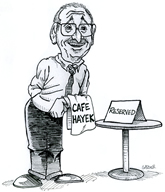Here’s a letter to Barron’s. (For alerting me to this essay by Graf I thank Steven Kaufman.)
Editor:
Julia Graf’s attempt to justify Trump’s tariffs misfires on several fronts; here are three (“The Inflation Panic Is All Wrong. How Tariffs Could Lead to Interest Rate Cuts.” August 14).
First, Ms. Graf slays a straw man when she correctly argues that tariffs will have little to no effect on the price level: Higher prices for protected outputs will largely be offset by lower prices for unprotected outputs. Contrary to Ms. Graf’s supposition, therefore, the core economic case against protective U.S. tariffs isn’t that these levies will fuel inflation but, rather, that they’ll pull resources away from industries for which Americans have a comparative advantage and into industries for which Americans have a comparative disadvantage. Although the result over time will be economic productivity (and, hence, living standards) lower than otherwise, it’s unlikely that this effect will be able to be isolated in measures of aggregate inflation.
Second, it’s untrue that Trump’s first-term tariffs “helped pull some manufacturing back. From 2017 to early 2020, the economy added roughly 500,000 manufacturing jobs, outpacing the pre-tariff growth rate.” Ms. Graf mistakes manufacturing employment for manufacturing output. Manufacturing output was slightly lower in January 2020 (the month before covid hysteria took hold) than it was in January 2017. Tellingly, manufacturing output did rise somewhat from early 2017 through the summer of 2018, when Trump’s tariffs began earnestly kicking in. But from September 2018 through January 2020, this output fell by 3.1 percent. Manufacturing employment rose only because the productivity of manufacturing workers fell: The hourly productivity of manufacturing workers fell in each quarter starting in the third quarter of 2018 through the fourth quarter of 2019. These data are consistent with economists’ argument that protective tariffs reduce productivity.
Third, it’s also untrue that manufacturing capacity expanded during Trump’s first term. In fact, it shrunk, being 2 percent lower in January 2020 than in January 2017.
It’s easy to make a case for protectionism by getting the facts wrong, but it’s almost impossible to do so when getting the facts right.
Sincerely,
Donald J. Boudreaux
Professor of Economics
and
Martha and Nelson Getchell Chair for the Study of Free Market Capitalism at the Mercatus Center
George Mason University
Fairfax, VA 22030



